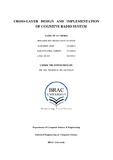| dc.contributor.advisor | Khan, Md. Muhidul Islam | |
| dc.contributor.author | Mohiuddin, Ibrahim Bin | |
| dc.contributor.author | Anis, Nawshin | |
| dc.contributor.author | Ahmed, Saraf Wamia | |
| dc.contributor.author | Anan, Zaki | |
| dc.date.accessioned | 2016-05-31T12:35:20Z | |
| dc.date.available | 2016-05-31T12:35:20Z | |
| dc.date.copyright | 2016 | |
| dc.date.issued | 2016-03 | |
| dc.identifier.other | ID 16141026 | |
| dc.identifier.other | ID 12110015 | |
| dc.identifier.other | ID 12110030 | |
| dc.identifier.other | ID 16141027 | |
| dc.identifier.uri | http://hdl.handle.net/10361/5419 | |
| dc.description | This thesis report is submitted in partial fulfillment of the requirements for the degree of Bachelor of Science in Computer Science and Engineering, 2016. | en_US |
| dc.description | Cataloged from PDF version of thesis report. | |
| dc.description | Includes bibliographical references (page 35-36). | |
| dc.description.abstract | Demand of ever-present wireless services requires the use of more spectrum resources. However, present wireless networks are segmented by a fixed spectrum allocation policy. This fixed allocation of spectrum has lead to unused or underutilized bandwidth (namely spectrum holes) where opportunistic spectrum sharing increased its efficiency.
To address this problem, cognitive radio is being uplifted as an emerging solution which uses intelligent technology to autonomously adapt in operating parameters in dynamic conditions. This paper starts with the illustrations of cognitive radio and classifications of spectrum sensing techniques which are then simulated by providing manual parameters through an algorithm in MATLAB. The simulation consist a set of dummy primary users who are set with specific bandwidth and using energy detection technique those spectrum bands are allocated dynamically to a set of secondary users during the idle period of the primary users. Lastly, a signal to noise ratio (SNR) manipulation has been implemented to observe how spectrum sensing is affected which in turn aided to understand spectrum allocation.
Page | en_US |
| dc.description.statementofresponsibility | Ibrahim Bin Mohiuddin | |
| dc.description.statementofresponsibility | Nawshin Anis | |
| dc.description.statementofresponsibility | Saraf Wamia Ahmed | |
| dc.description.statementofresponsibility | Zaki Anan | |
| dc.format.extent | 36 pages | |
| dc.language.iso | en | en_US |
| dc.publisher | BRAC University | en_US |
| dc.rights | BRAC University thesis are protected by copyright. They may be viewed from this source for any purpose, but reproduction or distribution in any format is prohibited without written permission. | |
| dc.subject | Computer science and engineering | en_US |
| dc.subject | CSE | en_US |
| dc.subject | Cognitve radio system | en_US |
| dc.title | Cross-layer design and implementation of cognitve radio system | en_US |
| dc.type | Thesis | en_US |
| dc.contributor.department | Department of Computer Science and Engineering, BRAC University | |
| dc.description.degree | B. Computer Science and Engineering | |

